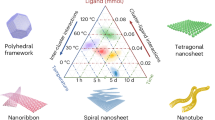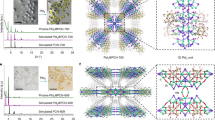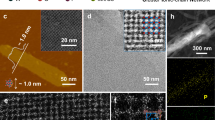Abstract
Atomic-level manufacturing enables the bottom-up fabrication of nanomaterials with tailored structures and properties. Clusters with atomic precise structures can be used as superatom building blocks to construct superstructures with exceptional properties beyond their individual properties. However, the programmable and large-scale synthesis of cluster assemblies remains challenging. This protocol describes the detailed experimental procedures for the modular assembly of polyoxometalate (POM) clusters into subnanomaterials by programmable interactions under simple and mild conditions. In this approach different types of POM clusters (0.7–1.8 nm in size) are coated with quaternary ammonium or oleylamine ligands using either two-phase or solvothermal methods. The assembly process depends on the interactions between atom clusters, ligands and the reaction matrix, all of which can be modified to generate a library of subnanometer superstructures. The four intercluster connection modes are metal cation-induced coordinative connection, anion bridged covalent connection, synergistic noncovalent interaction and cluster–nucleus co-assembly. A library that includes single-cluster nanowires, clusterphenes and nanosheets with single-cluster thicknesses, can be prepared within 3–12 h. Owing to their ultrahigh surface atom ratio and electron delocalization, the resulting subnanometer POM assemblies with rich structural and compositional diversity exhibit excellent properties and application potential in terms of mechanics, catalysis and chirality. This procedure is suitable for users with prior expertise in the synthesis of inorganic and cluster-based nanomaterials.
Key points
-
This protocol describes a general synthetic strategy for the modular assembly of polyoxometalate (POM) clusters to construct subnanomaterials.
-
This strategy provides rich structural and compositional diversity for the design of POM-based nanomaterials with programmable connection modes and advanced properties not seen in free POMs or crystals.
This is a preview of subscription content, access via your institution
Access options
Access Nature and 54 other Nature Portfolio journals
Get Nature+, our best-value online-access subscription
$32.99 / 30 days
cancel any time
Subscribe to this journal
Receive 12 print issues and online access
$259.00 per year
only $21.58 per issue
Buy this article
- Purchase on SpringerLink
- Instant access to full article PDF
Prices may be subject to local taxes which are calculated during checkout










Similar content being viewed by others
Data availability
All data supporting the findings of this study are included in the article and the references listed in the Supplementary Information. Source data are provided with this paper.
References
Feynman, R. P. There’s plenty of room at the bottom. J. Microelectromech. Syst. 1, 60–66 (1992).
Lehn, J. M. Perspectives in supramolecular chemistry—from molecular recognition towards molecular information processing and self-organization. Angew. Chem. Int. Ed. 29, 1304–1319 (1990).
Whitesides, G. M. & Grzybowski, B. Self-assembly at all scales. Science 295, 2418–2421 (2002).
Eigler, D. M. & Schweizer, E. K. Positioning single atoms with a scanning tunneling microscope. Nature 344, 524–526 (1990).
Brune, H., Giovannini, M., Bromann, K. & Kern, K. Self-organized growth of nanostructure arrays on strained metallic substrates. Nature 394, 451–453 (1998).
Jena, P. & Sun, Q. Super atomic clusters: design rules and potential for building blocks of materials. Chem. Rev. 118, 5755–5870 (2018).
Doud, E. A. et al. Superatoms in materials science. Nat. Rev. Mater. 5, 371–387 (2020).
Khanna, S. N. & Jena, P. Atomic clusters: building blocks for a class of solids. Phys. Rev. B 51, 13705–13716 (1995).
Long, D. L., Burkholder, E. & Cronin, L. Polyoxometalate clusters, nanostructures and materials: from self assembly to designer materials and devices. Chem. Soc. Rev. 36, 105–121 (2007).
Li, X. et al. A polymeric co-assembly of subunit vaccine with polyoxometalates induces enhanced immune responses. Nano Res. 15, 4175–4180 (2022).
Lian, L., Zhang, H., An, S., Chen, W. & Song, Y. F. Polyoxometalates-based heterogeneous catalysts in acid catalysis. Sci. China Chem. 64, 1117–1130 (2021).
Putaj, P. & Lefebvre, F. Polyoxometalates containing late transition and noble metal atoms. Chem. Rev. 255, 1642–1685 (2011).
Anyushin, A. V., Kondinski, A. & Parac-Vogt, T. N. Hybrid polyoxometalates as post-functionalization platforms: from fundamentals to emerging applications. Chem. Soc. Rev. 49, 382–432 (2020).
Wang, S. S. & Yang, G. Y. Recent advances in polyoxometalate-catalyzed reactions. Chem. Rev. 115, 4893–4962 (2015).
Ji, Y., Huang, L., Hu, J., Streb, C. & Song, Y. F. Polyoxometalate-functionalized nanocarbon materials for energy conversion, energy storage and sensor systems. Energy Environ. Sci. 8, 776–789 (2015).
Busche, C. et al. Design and fabrication of memory devices based on nanoscale polyoxometalate clusters. Nature 515, 545–549 (2014).
Rhule, J. T., Hill, C. L., Judd, D. A. & Schinazi, R. F. Polyoxometalates in medicine. Chem. Rev. 98, 327–358 (1998).
Miras, H. N., Yan, J., Long, D. L. & Cronin, L. Engineering polyoxometalates with emergent properties. Chem. Soc. Rev. 41, 7403–7430 (2012).
Miras, H. N., Vilà-Nadal, L. & Cronin, L. Polyoxometalate based open-frameworks (POM-OFs). Chem. Soc. Rev. 43, 5679–5699 (2014).
Zhang, F., Li, H., Li, Z., Liu, Q. & Wang, X. Phase engineering of polyoxometalate assembled superstructures. Nat. Synth. 3, 1039–1048 (2024).
Zhang, S., Shi, W. & Wang, X. Locking volatile organic molecules by subnanometer inorganic nanowire-based organogels. Science 377, 100–104 (2022).
Zhang, F., Li, Z. & Wang, X. Mechanically tunable organogels from highly charged polyoxometalate clusters loaded with fluorescent dyes. Nat. Commun. 14, 8327 (2023).
Liu, Q. et al. Self-assembly of polyoxometalate clusters into two-dimensional clusterphene structures featuring hexagonal pores. Nat. Chem. 14, 433–440 (2022).
Li, Z., Zhang, Z., Hu, H., Liu, Q. & Wang, X. Synthesis of two-dimensional polyoxoniobate-based clusterphenes with in-plane electron delocalization. Nat. Synth. 2, 989–997 (2023).
Li, H. et al. A monolayer crystalline covalent network of polyoxometalate clusters. Sci. Adv. 9, eadi6595 (2023).
Liu, T., Diemann, E., Li, H., Dress, A. W. M. & Mu¨ller, A. Self-assembly in aqueous solution of wheel-shaped Mo154 oxide clusters into vesicles. Nature 426, 59–62 (2003).
Kistler, M. L., Bhatt, A., Liu, G., Casa, D. & Liu, T. A complete Macroion “Blackberry” assembly-Macroion transition with continuously adjustable assembly sizes in {Mo132} water/acetone systems. J. Am. Chem. Soc. 129, 6453–6460 (2007).
Liu, T. B. Supramolecular structures of polyoxomolybdate-based giant molecules in aqueous solution. J. Am. Chem. Soc. 124, 10942–10943 (2002).
Liu, G., Liu, T., Mal, S. S. & Kortz, U. Wheel-shaped polyoxotungstate [Cu20Cl(OH)24(H2O)12(P8W48O184)]25 macroanions form supramolecular “blackberry” structure in aqueous solution. J. Am. Chem. Soc. 128, 10103–10110 (2006).
Botar, B., Kogerler, P. & Hill, C. L. [{(Mo)Mo5O21(H2O)3(SO4)}12(VO)30(H2O)20]36−: a molecular quantum spin icosidodecahedron. Chem. Commun. 25, 3138–3140 (2005).
Zhang, J., Song, Y.-F., Cronin, L. & Liu, T. Self-assembly of organic inorganic hybrid amphiphilic surfactants with large polyoxometalates as polar head groups. J. Am. Chem. Soc. 130, 14408–14409 (2008).
Pradeep, C. P. et al. Synthesis of modular “inorganic organic–inorganic” polyoxometalates and their assembly into vesicles. Angew. Chem. Int. Ed. 48, 8309–8313 (2009).
Yin, P. et al. A double-tailed fluorescent surfactant with a hexavanadate cluster as the head group. Angew. Chem. Int. Ed. 50, 2521–2525 (2011).
Li, D. et al. Inorganic–organic hybrid vesicles with counterion- and pH controlled fluorescent properties. J. Am. Chem. Soc. 133, 14010–14016 (2011).
Soria-Carrera, H., Atrián-Blasco, E., Martín-Rapún, R. & Mitchell, S. G. Polyoxometalate–peptide hybrid materials: from structure–property relationships to applications. Chem. Sci. 14, 10–28 (2023).
Parac-Vogt, T. N. et al. Host–guest assemblies of polyoxovanadate clusters as supramolecular catalysts. Angew. Chem. Int. Ed. e202420773 (2024).
Zhang, G. et al. Supramolecular framework membrane for precise sieving of small molecules, nanoparticles and proteins. Nat. Commun. 14, 975 (2023).
Han, J. W. & Hill, C. L. A coordination network that catalyzes O2-based oxidations. J. Am. Chem. Soc. 129, 15094–15095 (2007).
Li, X. X. et al. Designed assembly of heterometallic cluster organic frameworks based on Anderson-type polyoxometalate clusters. Angew. Chem. Int. Ed. 55, 6462–6466 (2016).
Bu, W., Uchida, S. & Mizuno, N. Micelles and vesicles formed by polyoxometalate-block copolymer composites. Angew. Chem. Int. Ed. 48, 8281–8284 (2009).
Bao, Y.-Y., Bi, L.-H., Wu, L.-X., Mal, S. S. & Kortz, U. Preparation and characterization of Langmuir–Blodgett films of wheel-shaped Cu-20 tungstophosphate and DODA by two different strategies. Langmuir 25, 13000–13006 (2009).
Li, H., Sun, H., Qi, W., Xu, M. & Wu, L. Onionlike hybrid assemblies based on surfactant-encapsulated polyoxometalates. Angew. Chem. Int. Ed. 46, 1300–1303 (2007).
Wang, H. Y., Ren, L. J., Wang, X. G., Ming, J. B. & Wang, W. Insights into the self assembly of a heterocluster Janus molecule into colloidal onions. Langmuir 35, 6727–6734 (2019).
Yang, P. et al. Polyoxometalate–cyclodextrin metal–organic frameworks: from tunable structure to customized storage functionality. J. Am. Chem. Soc. 141, 1847–1851 (2019).
Noguchi, T., Chikara, C., Kuroiwa, K., Kaneko, K. & Kimizuka, N. Controlled morphology and photoreduction characteristics of polyoxometalate (POM)/lipid complexes and the effect of hydrogen bonding at molecular interfaces. Chem. Commun. 47, 6455–6457 (2011).
Khlifi, S. et al. Chaotropic effect as an assembly motif to construct supramolecular cyclodextrin–polyoxometalate-based frameworks. J. Am. Chem. Soc. 144, 4469–4477 (2022).
Liu, Q. et al. Visible light induced Ag–polyoxometalate coassembly into single-cluster nanowires. Adv. Mater. 34, 2206178 (2022).
Liu, Q. et al. Single molecule-mediated assembly of polyoxometalate single-cluster rings and their three-dimensional superstructures. Sci. Adv. 5, eaax1081 (2019).
Liu, Q. et al. Tuning the chirality evolution in achiral subnanometer systems by judicious control of molecule interactions. J. Am. Chem. Soc. 146, 12819–12827 (2024).
Li, Z. et al. Single-walled cluster nanotubes for single-atom catalysts with precise structures. J. Am. Chem. Soc. 146, 450–459 (2024).
Liu, J. et al. Incorporation of clusters within inorganic materials through their addition during nucleation steps. Nat. Chem. 11, 839–845 (2019).
Liu, J. et al. Au-polyoxometalates A-B-A-B type copolymer-analogue sub-1 nm nanowires. Small 17, e2006260 (2021).
Liu, J., Shi, W. & Wang, X. ZnO-POM cluster sub-1 nm nanosheets as robust catalysts for the oxidation of thioethers at room temperature. J. Am. Chem. Soc. 143, 16217–16225 (2021).
Zhang, S., Shi, W., Yu, B. & Wang, X. Versatile inorganic subnanometer nanowire adhesive. J. Am. Chem. Soc. 144, 16389–16394 (2022).
Shearer, M. J. et al. Complex and noncentrosymmetric stacking of layered metal dichalcogenide materials created by screw dislocations. J. Am. Chem. Soc. 139, 3496–3504 (2017).
Acknowledgements
This work was supported by NSFC (grant nos. 92461314, 22241502, 22035004, 22250710677, 22305137).
Author information
Authors and Affiliations
Contributions
Q.L. and X.W. conceived and designed the experiments. F.Z. performed the experiments. Q.L. assisted the experiments. F.Z., Q.L. and X.W. drafted the manuscript and developed the protocol. All of the authors discussed the experiments and co-wrote the manuscript.
Corresponding authors
Ethics declarations
Competing interests
The authors declare no competing interests.
Peer review
Peer review information
Nature Protocols thanks Haralampos N. Miras and the other, anonymous, reviewer(s) for their contribution to the peer review of this work.
Additional information
Publisher’s note Springer Nature remains neutral with regard to jurisdictional claims in published maps and institutional affiliations.
Key references
Zhang, S. et al. Science 377, 100–104 (2022): https://doi.org/10.1126/science.abm7574
Liu, Q. et al. Nat. Chem. 14, 433–440 (2022): https://doi.org/10.1038/s41557-022-00889-1
Liu, J. et al. Nat. Chem. 11, 839–845 (2019): https://doi.org/10.1038/s41557-019-0303-0
Li, Z. et al. Nat. Synth. 2, 989–997 (2023): https://doi.org/10.1038/s44160-023-00305-7
Zhang, F. et al. Nat. Synth. 3, 1039–1048 (2024): https://doi.org/10.1038/s44160-024-00569-7
Li, H. et al. Sci. Adv. 9, eadi6595 (2023): https://doi.org/10.1126/sciadv.adi6595
Supplementary information
Supplementary Information
Supplementary Methods, and Table 1.
Source data
Source Data Tables 1 and 2
Detailed information about the synthesis of various NdPW11 nanosheets. Detailed information about the semi-hydrogenation reaction.
Rights and permissions
Springer Nature or its licensor (e.g. a society or other partner) holds exclusive rights to this article under a publishing agreement with the author(s) or other rightsholder(s); author self-archiving of the accepted manuscript version of this article is solely governed by the terms of such publishing agreement and applicable law.
About this article
Cite this article
Zhang, F., Shi, W., Liu, Q. et al. Modular assembly of polyoxometalate clusters at the sub-1 nm scale. Nat Protoc (2025). https://doi.org/10.1038/s41596-025-01212-1
Received:
Accepted:
Published:
DOI: https://doi.org/10.1038/s41596-025-01212-1



